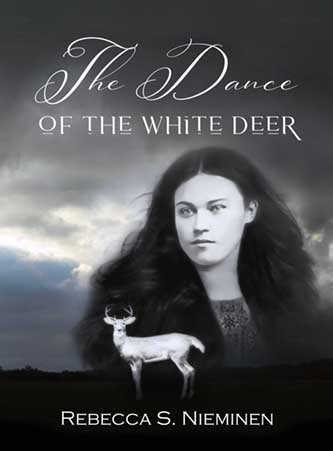Author’s First Novel Has a Historical Touch
Local author Rebecca Nieminen could not forget the sad story of Frances Maria Buel, a teenager who was murdered by her stepfather nearly 200 years ago.
Nieminen studied the crime and the short life of the 16-year-old girl who was stabbed to death on her family’s farm in Gustavus Township after rejecting her stepfather’s sexual advances.
After 20 years of research, writing and revisions, Nieminen this month released “The Dance of the White Deer,” her first novel. It is inspired by and loosely based on the tragic story of the teenager.
The novel is Nieminen’s first, and it represents a lifelong goal of hers. She has already written the sequel but has no publication date set.
“The Dance of the White Deer” (262 pages) is self-published and is available as an ebook or a paperback on amazon.com.

Nieminen, who is also a professional photographer and holds a master’s degree in English, stressed that while she based her novel on the true story of Buel, her novel is not the same story.
“However, I credit this girl for inspiring me to create my work of fiction,” said the Kinsman resident. “There are threads of her truth in my book, and without learning about her story, I would not have written my novel.”
Maria Frances Buel was murdered in 1832 by her stepfather, Ira Gardner, after she rejected his advances and ran to a neighbor’s home.
Gardner promised not to bother her if she returned home to pick up her clothing, but when she did, he stabbed her in the yard in front of witnesses.
The murder caused a sensation, and Gardner was eventually hanged. The story of Buel’s death is inscribed on her tombstone, which sits in Gustavus Town Hall, although a replica is in the town cemetery.
Nieminen said that in her novel, she also delves into the issues and conditions women faced in everyday life during that era.
She uncovered the story more than a decade ago when writing a “haunted Halloween” story for the original Youngstown Vindicator, where she was working as a reporter.
“I was immediately fascinated and wanted to know more about her tragic life,” she said. “I had long been a serious history buff and had already done a fair amount of research on [pioneer] life in Ohio, so it seemed natural that a novel started taking shape in my mind.”
But Nieminen wasn’t interested in Buel as fodder for a ghost story.
“I was more interested in imagining what it must have been like for a young, vulnerable girl to be stuck under the same roof with this grown man who was attempting to victimize her,” she said. “I felt a deep empathy for her.”
The author’s research uncovered more details about Buel’s life.
“I learned she had been a brunette beauty, and a ‘bastard child,’” the author said. ‘She had a boyfriend who married someone else after the murder and migrated to Indiana.”
Nieminen’s novel is based on two characters she created: 16-year-old Limery Clark and her 19-year-old boyfriend, Aaron Harper.
Aaron comes from an upstanding family and doesn’t comprehend the shameful weight of Limery’s hardscrabble upbringing or the terribleness of her situation as the target of her stepfather’s lust.
The two young lovers marry but the secrets she holds become a burden that cannot be maintained.
Nieminen said she has been interested in the history of the Western Reserve since she was a teen.
“It had always been an interest and a hobby,” she said. “When I wrote about [the Frances Buel story] for The Vindicator, I was in my late 20s. I felt a lot of empathy for her. Even today, if someone is being sexually abused by a family member, it goes under the radar, and it was even more so in those days. Even today, this would be a shocking story, a ‘Dateline’ story.”
The author strove for historical accuracy in capturing the language and everyday rhythms of life in the early 1800s.
“I wanted everything to be as accurate as possible,” she said. “There is a scene where someone is smoking a clay pipe and I thought, ‘wait a minute… how long does it take to do that?’ I would have to research it. I fell down so many rabbit holes like that, one detail after another.”
Nieminen also tried to remain true to the speech patterns of the day. She points out that the word “hello” as a common catch-all greeting did not become common until around 1900.
Challenges in her own life – divorce, raising two children as a single mother – also slowed her writing progress.
She eventually finished the novel and entered it into the 2013 Eludia Award contest, which is geared toward women writers over 40. She was named a top 10 finalist, but did not win the prize, which was publication of the novel.
“I was on a list with women who had [doctoral degrees] in creative writing, attorneys,” she said. “Overall, it was good company to keep. But I didn’t win, and the manuscript got placed on the back burner again. I was busy making ends meet, working, raising my kids.”
It was her son who pushed her to complete the last mile.
“This year, my son asked me, as a birthday present to him, to get the novel out there on Amazon and publish it myself,” she said. ‘I was really touched that he cared enough to want me to do that.”
She was unsure about the perceived credibility of a self-published book and wanted to obtain a “real” publisher. But it’s a tough task for a first-time writer.
“Self-publishing is more respectable now and a lot of authors take that route, so I decided I would do it,” she said.
Nieminen hopes the novel finds its way into the hands of a publisher, who might contact her.
“I figure that I have a better shot of it going somewhere if I get it out there rather than it sitting in my computer and never seeing the light of day,” she said.
Copyright 2024 The Business Journal, Youngstown, Ohio.



